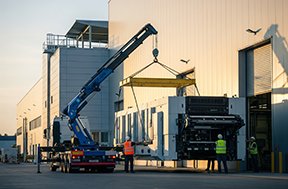Published: July 24, 2025 | Updated: October 23, 2025
Published: July 24, 2025 | Updated: October 23, 2025
Mastering Equipment Procurement and Asset Acquisition
 This time, we'll take a deep dive into equipment procurement. In the landscape of modern commerce, businesses consistently acquire essential physical resources. These range from fleet vehicles to specialized manufacturing processors. When these crucial assets reach the end of their operational lifespan, demanding replacements, companies embark on a critical process known as equipment procurement.
This time, we'll take a deep dive into equipment procurement. In the landscape of modern commerce, businesses consistently acquire essential physical resources. These range from fleet vehicles to specialized manufacturing processors. When these crucial assets reach the end of their operational lifespan, demanding replacements, companies embark on a critical process known as equipment procurement.
What exactly does "equipment procurement" entail? This comprehensive article explores the intricate details, providing clarity on its definition, the methodical steps involved, the hurdles companies face, and the valuable role a Computerized Maintenance Management System (CMMS) plays in this vital endeavor.
What Is Equipment Procurement? A Strategic Asset Acquisition Approach
At its core, equipment procurement represents the strategic process of acquiring necessary tools, machinery, or other tangible assets vital for a company's ongoing operations. This involves a meticulous series of actions. First, identifying specific equipment needs, then carefully evaluating potential suppliers, negotiating favorable contracts, and finally, overseeing the delivery and seamless installation of the new equipment. These steps, while appearing straightforward, demand careful execution for successful outcomes.
The Equipment Procurement Process: Step-by-Step Breakdown
Needs Assessment: Pinpointing Your Precise Requirements
The journey begins with a thorough needs assessment. Here, you must pinpoint the exact equipment required to achieve your company's objectives. This stage demands a comprehensive analysis of current operations, meticulously identifying any bottlenecks or inefficiencies hindering productivity. Determining the precise type and capacity of equipment you truly require forms the foundation of this process.
Neglecting this crucial phase can lead to costly errors. Convene meetings with all relevant departments: maintenance, production, purchasing, and management. This collaborative approach prevents acquiring an item that either exceeds budget limitations or fails to meet your functional demands due to design flaws or inadequate capabilities.
Supplier Research: Finding the Right Partners
Once you clearly define your equipment needs, companies embark on researching potential suppliers. This involves identifying vendors with the necessary expertise, extensive experience, and a sterling reputation. Leverage various resources, including online directories, specialized industry publications, and valuable recommendations from other businesses. This diligent research establishes a pool of credible candidates.
Request for Proposals (RFPs): Soliciting Detailed Information
To gather detailed information from the identified potential suppliers, companies frequently issue Request for Proposals (RFPs). These formal documents meticulously outline the specific equipment requirements, desired delivery timelines, and other pertinent criteria. Suppliers then submit comprehensive proposals detailing their offerings, pricing structures, and terms and conditions. The RFP process standardizes submissions, facilitating easier comparison.
Evaluation and Selection: Making Informed Choices
After receiving all proposals, companies must rigorously evaluate each supplier based on various critical factors. These include the proposed price, the quality of the equipment, anticipated delivery times, warranty provisions, and the level of after-sales support offered. The objective remains clear: select a supplier whose offerings most effectively align with the carefully established criteria.
Negotiation: Securing Favorable Terms
Once you select a preferred vendor, negotiations commence to finalize the contract's terms. Discussions encompass pricing, payment schedules, delivery timelines, warranty specifics, and any other relevant details. This phase aims to achieve mutually beneficial agreements, safeguarding the company's interests.
Contract Execution: Formalizing the Agreement
Upon completing successful negotiations, a formal contract materializes, and both parties sign it. This legally binding document outlines the agreed-upon terms and conditions, providing legal protection for both the company acquiring the equipment and the supplier providing it.
Delivery and Installation: Bringing the Asset to Life
The supplier then delivers the equipment and often handles the installation. This may involve dispatching on-site technicians or utilizing specialized equipment to ensure proper setup and full functionality. A smooth delivery and installation process prevents delays and operational disruptions.
Acceptance and Payment: Finalizing the Transaction
Following successful installation and comprehensive testing, the company formally accepts the equipment and makes the agreed-upon payment. This final step marks the culmination of the procurement process, officially transferring ownership and responsibility.
Overcoming Equipment Procurement Challenges
While the steps outlined above paint a clear picture, companies often encounter challenges during the procurement journey. Understanding these "roadblocks" and formulating proactive solutions proves essential for success.
Budget Constraints: Doing More with Less
Limited financial resources frequently complicate acquiring the most desirable equipment. Companies must prioritize their needs and diligently explore cost-effective alternatives. This may involve considering certified used equipment, lease options, or innovative financing solutions.
Technological Complexity: Keeping Pace with Innovation
Rapid technological advancements make staying current with the latest equipment options a constant challenge. Companies need to invest in research and development to understand emerging technologies and consider specialized training for their personnel to operate and maintain new equipment effectively.
Supplier Reliability: Vetting Your Partners Carefully
Identifying truly reliable suppliers demands significant time and effort. Companies must practice thorough due diligence to avoid dealing with unreliable or even fraudulent vendors. This includes checking references, reviewing past performance, and assessing financial stability.
Lead Times: Planning for the Long Haul
Remember, the entire process, from initial meetings to the asset's actual operational use, can extend over a considerable period. Plan ahead, especially for specialized or custom-built items, where manufacturing and delivery times can be extensive. Proactive scheduling mitigates delays.
Regulatory Compliance: Adhering to Industry Standards
Depending on the industry and geographical location, companies may face specific regulations or standards they must meet when procuring equipment. Understanding these regulatory requirements beforehand prevents costly non-compliance issues and ensures safe operation.
Asset Acquisition Planning: Key Considerations Before Purchasing
Before committing to equipment procurement, companies should meticulously review several critical factors. Incorporating these considerations early in the planning stages prevents costly missteps and ensures alignment with overall business goals.
Discover how streamlined maintenance processes can elevate production. Learn more.
Cost-Benefit Analysis: Weighing the Value
Evaluate the potential benefits the equipment offers against its associated costs. This includes not only the purchase price but also ongoing maintenance expenses, energy consumption, and disposal costs. A sound cost-benefit analysis helps justify the investment.
For guidance on conducting a thorough cost-benefit analysis, the Harvard Business School offers valuable insights.
Return on Investment (ROI): Measuring the Payback
Calculate the expected Return on Investment (ROI) to determine the purchase's true worth. A favorable ROI indicates the equipment will generate sufficient financial benefits to justify its initial outlay and ongoing costs.
Scalability: Future-Proofing Your Investment
Consider whether the equipment will accommodate future growth or changes in business needs. Investing in scalable solutions avoids premature replacements and maximizes the asset's useful life.
Maintenance and Support: Ensuring Continued Operation
Evaluate the availability and quality of maintenance and support services from the supplier. Reliable technical assistance and readily available spare parts minimize downtime and extend the equipment's lifespan.
Environmental Impact: Responsible Procurement
Increasingly, companies consider the equipment's environmental footprint. This includes energy consumption, waste generation, and the potential for recycling. Selecting environmentally conscious options aligns with sustainability goals.
Have these factors firmly in mind before you even begin the search for vendors. Discuss these comprehensively in your opening meetings, ensuring everyone involved understands the parameters guiding the decision-making process.
 How a CMMS Enhances Equipment Procurement and Asset Tracking
How a CMMS Enhances Equipment Procurement and Asset Tracking
Many companies recognize the immense value of CMMS software for organizing their existing maintenance programs. However, when you look beyond merely preventive maintenance (PM) and work order processes, a CMMS offers significant assistance for overall asset management, extending its utility into the procurement realm.
Centralized Asset Information
With a CMMS, you establish a centralized database for all your asset records. List each asset along with any relevant information, including its function, precise location within the facility, initial cost, and manufacturer's guidelines. This comprehensive digital record provides a single source of truth.
Tracking Lifecycle and Performance
Assign inventory and PMs to each asset within the CMMS. Immediately, you gain a clear grasp of the equipment's lifecycle. You can collect further data by tracking depreciation values. A CMMS offers several options for this, depending on how your company tracks financial depreciation. You also have immediate access to a complete maintenance history and associated costs. Make sure you include these vital statistics in any reports and discussions concerning equipment viability or replacement.
Key Performance Indicators (KPIs) and Reporting
A CMMS provides key performance indicator (KPI) reports. These reports offer actionable insights into asset performance, reliability, and maintenance costs, directly informing procurement decisions.
System Integration for Informed Decisions
Don't overlook the power of integration. With assistance from your CMMS provider, you can connect the CMMS to other crucial business systems. This data exchange passes along valuable information that proves invaluable when discussing equipment procurement, providing a holistic view of asset performance and financial implications.
Purchasing Modules and Vendor Management
A Computerized Maintenance Management System (CMMS) is a powerful tool that significantly enhances a company's equipment procurement process. By centralizing asset information and providing valuable insights throughout the procurement lifecycle, it improves decision-making. Purchasing departments can use the same CMMS as maintenance, accessing menus that offer vendor information, purchase requests, and purchase orders (POs). These POs provide extensive information regarding vendors, shipping logistics, and receiving details, consolidating all critical procurement data.
Bringing It All Together: Smarter Equipment Procurement Starts Here
The journey of equipment procurement, while detailed and extensive, demands a comprehensive understanding of its various facets. You would not simply visit the first dealer you encounter and purchase a car for personal use without conducting thorough research. Instead, you would determine the type of vehicle that truly fits your needs, establish a realistic budget, and explore potential loan payment plans. Subsequently, you would diligently seek a trusted dealer who offers the most favorable all-around deal.
If you apply such diligent steps and considerations to your personal life, then you undoubtedly want to apply similar rigorous processes when acquiring equipment for your workplace. And remember, a CMMS stands ready to help you maintain organization throughout this complex process. The world-class system from Mapcon Technologies provides you with features for assets, inventory, purchasing, and so much more. Call 800-922-4336 today for a free demonstration.
Frequently Asked Questions
What is equipment procurement and why is it important?
Equipment procurement is the strategic process of acquiring tools, machinery, or assets essential for operations, ensuring that companies invest wisely and maintain productivity.
What are the key steps in the equipment procurement process?
The process includes assessing needs, researching suppliers, issuing RFPs, evaluating proposals, negotiating terms, finalizing contracts, and managing delivery and installation.
What challenges do companies face during equipment procurement?
Common challenges include budget limitations, supplier reliability, long lead times, and compliance with industry regulations.
How does a CMMS support equipment procurement and asset management?
A CMMS centralizes asset data, tracks lifecycle performance, and provides valuable reports that guide purchasing and replacement decisions.
Why is MAPCON’s CMMS effective for managing procurement activities?
MAPCON CMMS streamlines vendor management, purchase orders, and maintenance tracking, giving teams full visibility across the asset acquisition process.
What factors should be evaluated before purchasing new equipment?
Companies should review ROI, scalability, maintenance support, cost-benefit ratio, and environmental impact to make informed procurement decisions.
MAPCON CMMS software empowers you to plan and execute PM tasks flawlessly, thanks to its wealth of features and customizable options. Want to see it for yourself? Click the button below to get your FREE 30-day trial of MAPCON!
Try It FREE!